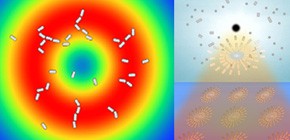
Using doughnut-like laser beams, success in selectively extracting and assembling Ag nanoparticles
Great potential for selectively extracting and assembling nanoparticles on substrates
Four groups of researchers led by Takuya IIDA (Tenure Track Lecturer, Research Organization for the 21st Century, Osaka Prefecture University) and Shoji ITO (Assistant Professor, Graduate School of Engineering Science, Osaka University) succeeded in selectively extracting uniform particles from metallic nanoparticle solutions and selectively assembling those particles into ring-like arrangements. Inspired by the evolutionary process of natural light-harvesting antenna (LHA) in bacteria, this group achieved this result by irradiating metallic nanoparticle solutions with light from a doughnut-like laser beam, special laser beams with either azimuthal or radial polarization.
Living organisms have evolved through exposure to external stimuli and environmental fluctuations and built response systems optimum for such stimuli. For example, the natural light-harvesting antenna in bacteria has a ring-like structure of different pigment molecules depending on habitat. The light absorption band of the ring-like structure varies according to its color/wavelength. These LHAs in bacteria have evolved over time with exposure to sunlight and thermal fluctuations in the local environment.
Through the use of doughnut-like laser beams, this joint group succeeded in assembling silver (Ag) nanoparticles in ring-shaped arrangements in water at room temperature, where temperature fluctuation effects were obviously present. The light source for bringing about this light-induced motility was a doughnut-like laser beam, in essence, a light source similar to that effected by natural light-harvesting antenna with its ring-like structure. By irradiating aqueous solutions containing Ag nanoparticles of various shapes with this doughnut-like laser beam and verifying the desired result, this joint group demonstrated the potential for selectively extracting and assembling nanoparticles on a substrate. Their achievement indicates the potential for extracting and assembling efficiently collected nanoparticles with properties desired in a wide field of nanotechnology -- nanoscale optical circuits, high performance solar cells, drugs, biosensors and catalysts.
These four groups conducted this joint research:
Theory group specializing in fluctuation-mediated nano opto-science: Takuya IIDA, Mamoru TAMURA, Shimpei HIDAKA, Hironori HATTORI
Laboratory group specializing in photo physical chemistry with super-high-speed laser spectrometry: Shoji ITO, Dr. Hiroaki YAMAUCHI, Professor Hiroshi MIYASAKA
Laboratory group specializing in fabrication of nano structures and analytical chemistry: Shiho TOKONAMI, Daichi HAMADA, Keisuke NISHIDA
Laboratory group specializing surface-enhanced Raman spectroscopy: Tamitake ITOH
Abstract
A highly efficient natural light-harvesting antenna has a ring-like structure consisting of dye molecules whose absorption band changes through selective evolutionary processes driven by external stimuli, i.e., sunlight depending on its territory and thermal fluctuations. Inspired by this fact, here, we experimentally and theoretically demonstrate the selective assembling of ring-like arrangements of many silver nanorods with particular shapes and orientations onto a substrate by the light-induced force of doughnut beams with different colours (wavelengths) and polarizations in conjunction with thermal fluctuations at room temperature. Furthermore, the majority of nanorods are electromagnetically coupled to form a prominent red-shifted collective mode of localized surface plasmons resonant with the wavelength of the irradiated light, where a spectral broadening also appears for the efficient broadband optical response. The discovered principle is a promising route for "bio-inspired selective optical assembly" of various nanomaterials that can be used in the wide field of nanotechnology.

Figure 1

Figure 2

Figure 3

Figure 4
To learn more about this research, please read the full research report entitled " Selective Optical Assembly of Highly Uniform Nanoparticles by Doughnut-Shaped Beams " at this page of the Scientific Reports website.
Related link :
- Department of Chemistry, Graduate School of Engineering Science , Osaka University
